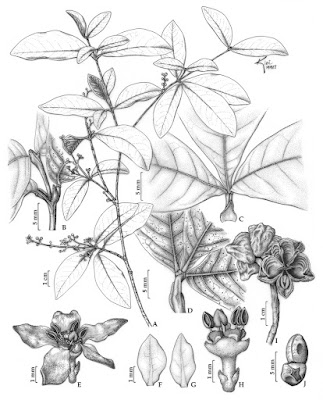 |
| Metrodorea concinna Pirani & P.Dias, in Dias, Udulutsch & Pirani, 2013. |
Abstract
A new species of Metrodorea (Rutaceae), M. concinna, is described and illustrated, and morphological, molecular phylogenetic, and distributional support for the new taxon and its relationships with morphologically similar species, as well as with sympatric ones, are explored. The new species is endemic to semideciduous forests of southeastern Bahia, eastern Brazil. It is distinct from other species of the genus mainly by the combination of shrubby to treelet habit, (sub)sessile leaves, sessile leaflets without conspicuous, dark glands on the abaxial surface, and by each carpel bearing one dorsal apophysis. In addition to the diagnostic morphological features, molecular data provide further support to the new taxon.
Keywords: Rutaceae, new species, Brazil
Metrodorea concinna Pirani & P.Dias, sp. nov.
Etymology:—The epithet concinna is derived from the Latin term concinnus, which means “pretty,”“neat,” “elegant,” referring to its habit and leaf arrangement.
Pedro Dias, Renata Giassi Udulutsch and José Rubens Pirani. 2013. A New Species of Metrodorea (Rutaceae) from Brazil: Morphology, Molecular Phylogenetics, and Distribution. Phytotaxa. 117(2); 35-41. DOI: 10.11646/phytotaxa.117.2.1